You’re in the 9th inning of the baseball game and a bunt comes tumbling your way. You grab the ball, wind up for the throw, and just as you throw your arm forward – yikes!! – your shoulder pops out of the socket!

A shoulder dislocation is always a shock and never a fun experience. Unfortunately, if it happens once, it’s likely to happen again.
Around 70% of people who dislocate their shoulder will likely do it again within 2 years.
Thankfully, there are ways you can manage the symptoms after a shoulder dislocation and decrease your risk of recurrence in the future.
What is a Shoulder Dislocation?
The shoulder is a ball and socket joint capable of 360-degree movement. You can move your shoulder in a complete circle on nearly every plane, but an issue occurs when a person has too much mobility. In this case, the joint is unstable. This is known as hyperlaxity or hypermobility. Hyperlaxity often occurs in younger patients, those with current injuries, or in people with significant weakness.
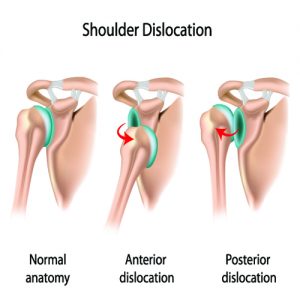 A shoulder dislocation occurs when an injury causes the head of the shoulder, or the ball, to become dislodged from the socket or whats call the Glenoid.
A shoulder dislocation occurs when an injury causes the head of the shoulder, or the ball, to become dislodged from the socket or whats call the Glenoid.
Think of the shoulder joint like a golf tee with a golf ball on top. In a dislocated shoulder, the ball is no longer on the tee but resting on the side of the tee. It is held there by the muscles and tendons.
Symptoms
 After a dislocated shoulder has been corrected, a person is often left with symptoms such as:
After a dislocated shoulder has been corrected, a person is often left with symptoms such as:
- Shoulder pain
- Difficulty moving the arm
- Swelling of the shoulder
- Muscle spasms and twitches
- The feeling of instability in the shoulder
- Fear of moving the arm, especially overhead
One or multiple dislocations leave a person predisposed to developing even more shoulder instability and weakness.
Exercise to Recover Quickly from a Shoulder Dislocation
Recovery from a Shoulder Dislocation
Healing from a shoulder dislocation takes dedication to your exercises. With the likely culprit being a form of weakness or laxity, this issue must be corrected to avoid re-injury. A Physical Therapist can help you initiate the rehab process, monitor your progress, and issue referrals as needed.
Healing Timeline & Exercise Protocol
You can expect at least 3 weeks away from your sport or activity while you work through your home rehab. Refer to the phases and recommended exercises below.
Always check with a licensed medical provider before beginning exercise post injury.
What to Avoid after a Dislocated Shoulder:
The most important goal after a shoulder dislocation is to let the shoulder heal and for the ligaments to scar down to prevent too much laxity long term.
For the first 2 weeks you want to avoid:
- Excessive shoulder external rotation – this stretches the front of the shoulder where most dislocations occur
- Reaching behind you – like reaching into the back seat
- Beaching cautious with stretching the arm above head height
- Wear a shoulder brace when resuming activity for the first 2 weeks
Week 1: Rest
Utilize activity limitation, pain controlling modalities (like ice), and gentle exercises to pave the pathway to recovery. The goal for this phase is to achieve a pain-free range of motion.
We also recommend wearing a shoulder brace in this phase to help with pain control and prevent your arm from moving into positions it shouldn’t.
Exercises Immediately After a Shoulder Dislocation
Fist in a box isometrics
- Keep your injured arm at your side, and bend your elbow as if you are about to hold a mug.
- Using your non-injured arm, apply gentle pressure on top of your injured side fist.
- Resist this pressure for about 5 seconds.
- You will repeat in the following directions: palm side, outside of hand, bottom of fist, front of fist.
- Complete 4 reps in each direction.
Scapular Clocks
- Relax your arm at your side and focus your effort to your shoulder blade.
- Lift your shoulder blade up, as if to 12 o’clock, keeping your arm relaxed.
- Return to rest, then shift your shoulder blade to 3, 6, and 9 o’clock positions.
- Repeat 4 times.
Shoulder Range of Motion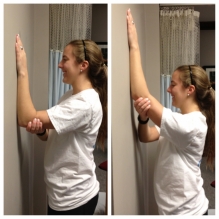
- Stand with your hand on a wall, about waist height.
- Slowly walk your fingers up the wall as high as you can tolerate.
- Walk your fingers back down.
- Turn your body perpendicular to the wall and repeat.
- Repeat for 4 walks in each direction.
Week 2-6: Rebuilding Strength and Stability
Begin adding resistance exercises to focus on strengthening and stabilizing the joint. Continue to address range of motion exercises as needed.
Exercises To Do
Shoulder External Rotation
- Wait closer to 3-4 weeks and progress gradually
- Secure a resistance band at about elbow height to something sturdy, like a stair railing.
- Stand perpendicular to the door, with your good arm facing the band.
- Hold the band in your injured arm, keep your elbow bent at 90 degrees and pinned at your side.
- Rotate your arm externally to pull against the resistance band. Be sure to control your motion.
- Complete 12 reps and 3 sets.
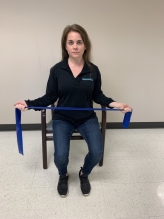
Shoulder Internal Rotation
- Continuing from the previous exercise, rotate your body so your injured arm is facing the band.
- Hold the band in that hand with your elbow bent to 90 degrees, keeping your elbow pinned at your side.
- Rotate your arm across your body to pull against the resistance.
- Complete 12 reps and 3 sets.
Shoulder Extension
- Turn your body to face the resistance band.
- Hold the band with your injured arm and keep your elbow straightened.
- Extend your arm behind you, keeping your chest facing forward.
- Complete 12 reps and 3 sets.
Plank Shifts
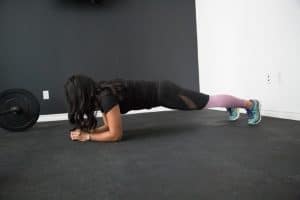
Assume the plank position. If ground-level is too uncomfortable, you can complete this on a wall.
- Shift your weight back and forth between each hand.
- Repeat for 30 sec and 3 reps.
Week 6 & Beyond: Maintain Strength and Shoulder Stability
Continue to implement strengthening exercises in your regular routine. Being to incorporate more dynamic motions and sports-specific actions, if applicable.
Return to Sport After a Shoulder Dislocation
When your injured shoulder is able to match range of motion and strength of your non-injured side, return to sport is appropriate.
Depending on arm dominance and contact during your sport you can expect to return to sports within 4- 8 weeks after a shoulder dislocation. Always check with your medical provider first.
If you are playing a contact sport, then we do recommend wearing a shoulder brace for sports that you would wear for the first 3 months after. This is to help prevent a reoccurring dislocation.
Tips to speed up recovery
Don’t return to activity too soon
Before jumping back into your sport or recreational activities, you need to be sure that your shoulder is up for the task. As mentioned at the beginning of this article, recurrence of dislocation is very likely! For this reason, it’s important to be intentional and consistent with a home rehab program.
Consult a physical therapist
Especially in the case of multiple recurrences of dislocation, a more graded rehabilitation may be necessary. In other cases, a physical therapist will be able to advise a patient on pursuing surgical options as appropriate.
In Review
Shoulder dislocations are tricky injuries that have a high rate of recurrence. Focusing your recovery efforts on gaining strength and stability will aid in reducing your risk or re-injury. Otherwise, consultation with a physical therapist can be a great starting point!
Works Referenced:
Hayes K, Callahan M, Walton J, Paxinos A, Murrell G. Shoulder instability: management and rehabilitation. Journal of Orthopaedic & Sports Physical Therapy. 2022; 32(10):497-509. https://www.jospt.org/doi/abs/10.2519/jospt.2002.32.10.497
Wang R, Arceiro R, Mazzocca A. The recognition and treatment of first-time shoulder dislocation in active individuals. Journal of Orthopaedic & Sports Physical Therapy. 2009; 39(2): 118-123. https://www.jospt.org/doi/10.2519/jospt.2009.2804
Watson S, Allen S, Grant J. A clinical review of return-to-play considerations after anterior shoulder dislocation. Sports Health. 2016; 8(4): 336-341. https://www.ncbi.nlm.nih.gov/pmc/articles/PMC4922522/
Image from: https://www.childrenshospital.org/conditions-and-treatments/conditions/s/shoulder-dislocation
Other Helpful Rehab Related Articles
GLP Weight Loss and Back Health: Effective Strategies and Insights
How to Stay Active After Cervical Fractures: Expert Tips and Advice
Dealing with Painful Stairs After Ankle Replacement Surgery
Walking After a Total Ankle Replacement: Tips for a Successful Recovery
Exercises While Non-Weight Bearing After Ankle Replacement: Elevation, AROM, Leg Raises, and More
Ankle Pain with Stairs: Causes and Home Treatment Options
Disclaimer: The information provided in this post is for educational purposes only. This is not a substitute for a medical appointment. Please refer to your physician before starting any exercise program.
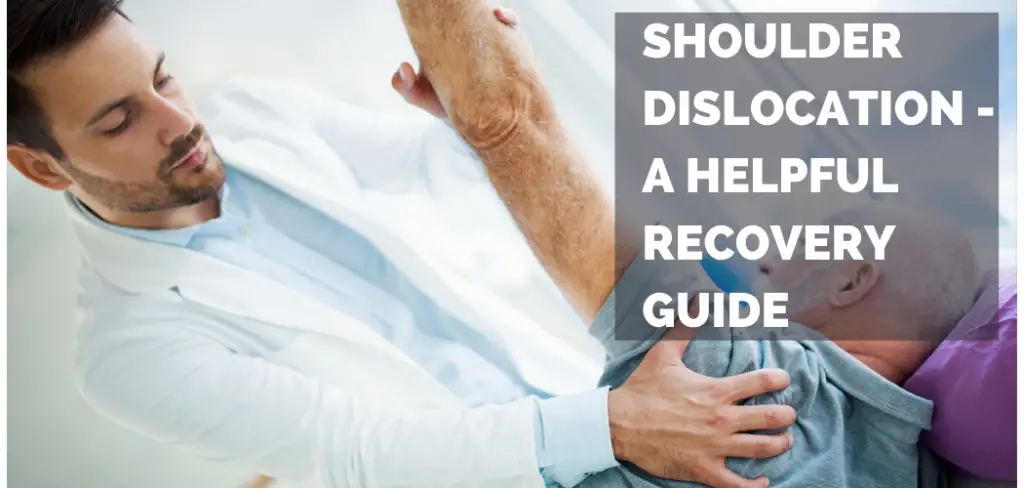







Comments are closed.